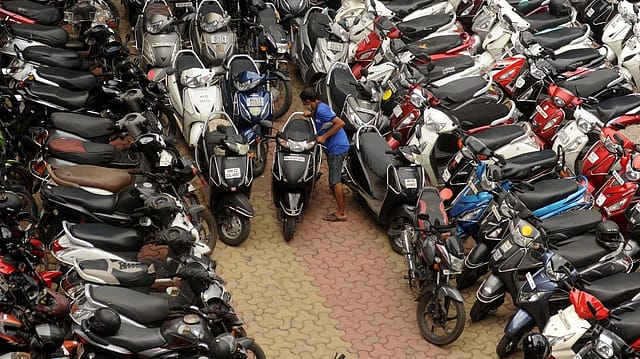Auto sales hit the brakes in July; 2-wheelers see 6.4% decline: FADA
ADVERTISEMENT

After three consecutive months of growth, India’s auto retail sector applied the brakes in July, with overall retails declining by 4.31% year-on-year, according to the Federation of Automobile Dealers Associations (FADA).
This pullback largely stems from a high-base effect in July 2024, when an extreme heat wave was immediately followed by excessive rainfall, constraining volumes before a rebound later that month, said FADA President C S Vigneshwar.
Segment‐wise, three-wheelers, tractors and commercial vehicles (CVs) achieved growth of 0.83%, 10.96% and 0.23% year-on-year respectively, whereas two-wheelers, passenger vehicles (PV) and construction equipment (CE) contracted by 6.48%, 0.81% and 33.28%.
In the two-wheeler space, July saw a 6.48% year-on-year decline and a 6.28% month-on-month drop, as crop-sowing activities and prolonged heavy rains dampened rural footfalls more sharply than urban demand.
Dealers are nevertheless confident of a post-monsoon uptick, with several purchase decisions deferred to August ahead of the festive season—making strategic stock alignment and focused rural–urban engagement imperative for reviving momentum.
The passenger vehicle segment contracted by 0.81% year-on-year even as volumes surged 10.38% month-on-month, driven by robust rural demand. “The Aashaada period and auspicious delivery days, combined with targeted schemes, new-model introductions and aggressive rural marketing, powered hinterland sales that picked up decisively towards month-end,” said Vigneshwar.
December 2025
The annual Fortune 500 India list, the definitive compendium of corporate performance, is out. This year, the cumulative revenue of the Fortune 500 India companies has breached $2 trillion for the first time. Plus, find out which are the Best B-schools in India.
Urban demand, however, remained muted due to low enquiry and restrained customer sentiment. With inventory levels steady at around 55 days, calibrated discounting, streamlined finance facilitation and intensified urban outreach will be crucial for sustaining festive-season growth.
Commercial vehicles posted a modest 0.23% year-on-year increase and a 4.19% month-on-month uptick, led by urban momentum. Dealers cited new-model launches, aggressive marketing support, bulk institutional orders and timely stock availability as key drivers, alongside targeted schemes that bolstered school-bus volumes. In contrast, rural haulage demand remained fragmented amid heavy rainfall, seasonal softness in cement, coal and construction logistics, and slower financier disbursements, prompting many buyers to defer purchases to the post-monsoon period.
The tractor segment delivered robust performance, with volumes up 10.96% YoY and 14.9% MoM. “The timely release of enhanced agricultural subsidies and favourable monsoon rains—together with strengthened rural liquidity—spurred a marked increase in purchase intent. This resilience underscores the pivotal role of policy interventions in sustaining agri-rural demand,” said FADA.
In its near-term outlook, FADA said from an agrarian demand perspective, the monsoon outlook through September appears broadly supportive—India is projected to receive normal to above‐normal rainfall (approximately 106 % of the long‐period average), which should bolster crop prospects and rural liquidity—albeit with heightened localised flood and landslide risks in select eastern, northeastern and peninsular pockets
However, external headwinds have emerged as the U.S. administration’s imposition of an additional 25% tariff on Indian exports has precipitated a 0.4% dip in benchmark equity indices and a depreciation of the rupee, injecting volatility into financial markets. The resulting wealth erosion and import‐cost pressures on exporters could erode consumer confidence, trigger a precautionary rise in household savings and exert downward pressure on discretionary spending—including on vehicles—over the near term, cautioned the auto dealers’ body.
While monsoon tailwinds and festival fervour converge to energise demand, the spectre of export-tariff volatility and isolated weather shocks underscores the need for vigilant stewardship, said the FADA. “By harnessing precision-targeted promotions, partnership-driven finance solutions and dynamic rural–urban engagement, the industry can navigate these headwinds and anchor itself on a trajectory of sustained retail growth,” it added.
